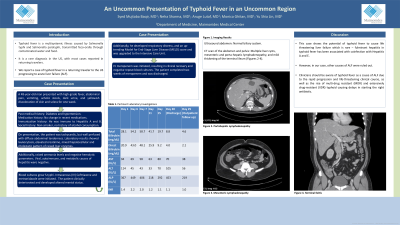Sunday Poster Session
Category: Liver
P1350 - An Uncommon Hepatic Presentation of Typhoid Fever in an Uncommon Region
Sunday, October 27, 2024
3:30 PM - 7:00 PM ET
Location: Exhibit Hall E

Has Audio

Syed Mujtaba Baqir, MD
Maimonides Medical Center
Brooklyn, NY
Presenting Author(s)
Syed Mujtaba Baqir, MD, Neha Sharma, MBBS, MD, Aruge Lutaf, MD, Monica Ghitan, MD, Yu Shia Lin, MD
Maimonides Medical Center, Brooklyn, NY
Introduction: Typhoid fever is a multisystemic illness caused by Salmonella typhi and Salmonella paratyphi, transmitted feco-orally through contaminated water and food. It is a health concern, especially in tropical and developing countries. It is a rare diagnosis in the US, with most cases reported in returning travelers. Hepatitis and cholestasis are rare sequela of salmonella infection however, acute liver failure (ALF) secondary to typhoid fever is exceptionally uncommon. We report a case of typhoid fever in a returning traveler to the US progressing to ALF.
Case Description/Methods: A 48-year-old man presented with high-grade fever, abdominal pain, vomiting, acholic stools, dark urine, and yellowish discoloration of skin and sclera for one week. His past medical history was significant for diabetes and hypertension. He was immune to Hepatitis A and B, with no recent change in medications. He is a non-smoker with no history of alcohol consumption. He returned from Pakistan 6 days prior to admission. On presentation, the patient was tachycardic, but well perfused with diffuse abdominal tenderness. Laboratory results showed leukocytosis, elevated creatinine, mixed hepatocellular and cholestatic pattern of raised liver enzymes, elevated ammonia levels, and negative hemolytic parameters. Viral, autoimmune, and metabolic causes of hepatitis were negative. Ultrasound abdomen revealed a normal biliary system and computerized tomography (CT) scan of the abdomen showed multiple liver cysts, mesenteric and porta-hepatis lymphadenopathy, and mild thickening of the terminal ileum. Blood cultures grew S.typhi. Intravenous (IV) Ceftriaxone and metronidazole were initiated. The patient clinically deteriorated and developed altered mental status, respiratory distress, and an up-trending Model for End-Stage Liver Disease (MELD) score and was upgraded to the Intensive Care Unit. IV meropenem was initiated, resulting in clinical recovery and negative repeat blood cultures. The patient completed two weeks of meropenem and was discharged.
Discussion: This case shows the potential of typhoid fever to cause life threatening liver failure which is rare – fulminant hepatitis in typhoid fever has been associated with coinfection with Hepatitis A and E. However, in our case, other causes of ALF were ruled out. Clinicians should be aware of typhoid fever as a cause of ALF due to the rapid progression and life-threatening clinical course, as well as the rise of MDR and XDR typhoid causing delays in starting the right antibiotic.
Disclosures:
Syed Mujtaba Baqir, MD, Neha Sharma, MBBS, MD, Aruge Lutaf, MD, Monica Ghitan, MD, Yu Shia Lin, MD. P1350 - An Uncommon Hepatic Presentation of Typhoid Fever in an Uncommon Region, ACG 2024 Annual Scientific Meeting Abstracts. Philadelphia, PA: American College of Gastroenterology.
Maimonides Medical Center, Brooklyn, NY
Introduction: Typhoid fever is a multisystemic illness caused by Salmonella typhi and Salmonella paratyphi, transmitted feco-orally through contaminated water and food. It is a health concern, especially in tropical and developing countries. It is a rare diagnosis in the US, with most cases reported in returning travelers. Hepatitis and cholestasis are rare sequela of salmonella infection however, acute liver failure (ALF) secondary to typhoid fever is exceptionally uncommon. We report a case of typhoid fever in a returning traveler to the US progressing to ALF.
Case Description/Methods: A 48-year-old man presented with high-grade fever, abdominal pain, vomiting, acholic stools, dark urine, and yellowish discoloration of skin and sclera for one week. His past medical history was significant for diabetes and hypertension. He was immune to Hepatitis A and B, with no recent change in medications. He is a non-smoker with no history of alcohol consumption. He returned from Pakistan 6 days prior to admission. On presentation, the patient was tachycardic, but well perfused with diffuse abdominal tenderness. Laboratory results showed leukocytosis, elevated creatinine, mixed hepatocellular and cholestatic pattern of raised liver enzymes, elevated ammonia levels, and negative hemolytic parameters. Viral, autoimmune, and metabolic causes of hepatitis were negative. Ultrasound abdomen revealed a normal biliary system and computerized tomography (CT) scan of the abdomen showed multiple liver cysts, mesenteric and porta-hepatis lymphadenopathy, and mild thickening of the terminal ileum. Blood cultures grew S.typhi. Intravenous (IV) Ceftriaxone and metronidazole were initiated. The patient clinically deteriorated and developed altered mental status, respiratory distress, and an up-trending Model for End-Stage Liver Disease (MELD) score and was upgraded to the Intensive Care Unit. IV meropenem was initiated, resulting in clinical recovery and negative repeat blood cultures. The patient completed two weeks of meropenem and was discharged.
Discussion: This case shows the potential of typhoid fever to cause life threatening liver failure which is rare – fulminant hepatitis in typhoid fever has been associated with coinfection with Hepatitis A and E. However, in our case, other causes of ALF were ruled out. Clinicians should be aware of typhoid fever as a cause of ALF due to the rapid progression and life-threatening clinical course, as well as the rise of MDR and XDR typhoid causing delays in starting the right antibiotic.
Disclosures:
Syed Mujtaba Baqir indicated no relevant financial relationships.
Neha Sharma indicated no relevant financial relationships.
Aruge Lutaf indicated no relevant financial relationships.
Monica Ghitan indicated no relevant financial relationships.
Yu Shia Lin indicated no relevant financial relationships.
Syed Mujtaba Baqir, MD, Neha Sharma, MBBS, MD, Aruge Lutaf, MD, Monica Ghitan, MD, Yu Shia Lin, MD. P1350 - An Uncommon Hepatic Presentation of Typhoid Fever in an Uncommon Region, ACG 2024 Annual Scientific Meeting Abstracts. Philadelphia, PA: American College of Gastroenterology.

